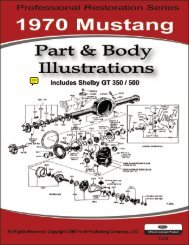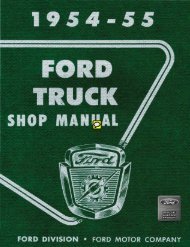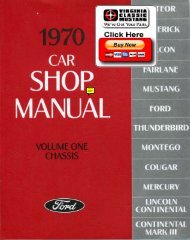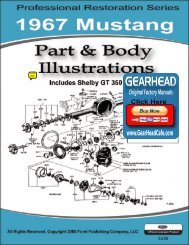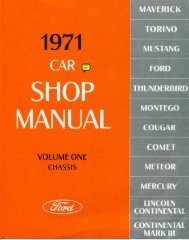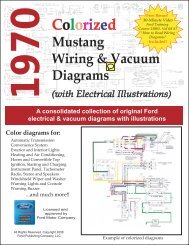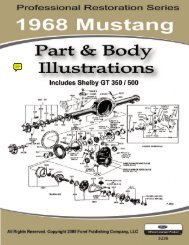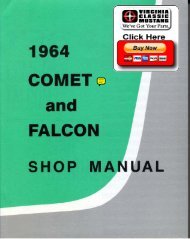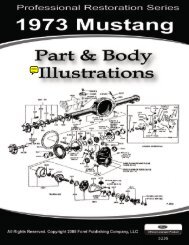DEMO - 1965 Ford Truck Shop Manual - ForelPublishing.com
DEMO - 1965 Ford Truck Shop Manual - ForelPublishing.com
DEMO - 1965 Ford Truck Shop Manual - ForelPublishing.com
You also want an ePaper? Increase the reach of your titles
YUMPU automatically turns print PDFs into web optimized ePapers that Google loves.
2-18 GROUP 2 - BRAKES<br />
hole in the adjusting lever from the<br />
backing plate side. The adjusting<br />
levers are stamped with an R or L to<br />
indicate their installation on a right<br />
or left hand brake assembly (Fig. 10).<br />
IDENTIFICATION LINES<br />
ADJUSTING SCREW<br />
ADJUSTING LEVER<br />
FIG. 10—Adjusting Screw and<br />
Lever Identification<br />
H1143-B<br />
11. Position the hooked end of<br />
the adjuster spring in the large hole<br />
in the primary shoe web, and connect<br />
the loop end of the spring to the adjuster<br />
lever hole.<br />
12. Pull the adjuster lever, cable<br />
and automatic adjuster spring down<br />
and toward the rear to engage the<br />
pivot hook in the large hole in the<br />
secondary shoe web (Fig. 2).<br />
13. After installation, check the<br />
action of the adjuster by pulling the<br />
section of the cable between the cable<br />
guide and the adjusting lever toward<br />
the secondary shoe web far enough<br />
to lift the lever past a tooth on the<br />
adjusting screw wheel. The lever<br />
should snap into position behind the<br />
next tooth, and release of the cable<br />
should cause the adjuster spring to<br />
return the lever to its original position.<br />
This return action of the lever<br />
will turn the adjusting screw one<br />
tooth.<br />
If pulling the cable does not produce<br />
the action described, or if the<br />
lever action is sluggish instead ot<br />
positive and sharp, check the position<br />
of the lever on the adjusting<br />
screw toothed wheel. With the brake<br />
in a vertical position (anchor at the<br />
top), the lever should contact the adjusting<br />
wheel one tooth above the<br />
center line of the adjusting screw.<br />
If the contact point is below this center<br />
line, the lever will not lock on the<br />
teeth in the adjusting screw wheel,<br />
and the screw will not be turned as<br />
the lever is actuated by the cable.<br />
To determine the cause of this<br />
condition:<br />
a. Check the cable end fittings.<br />
The cable should <strong>com</strong>pletely fill or<br />
extend slightly beyond the crimped<br />
section of the fittings. If it does not<br />
meet this specification, possible damage<br />
is indicated and the cable assembly<br />
should be replaced.<br />
b. Check the cable length. The<br />
cable should measure 11V4 inches<br />
(plus or minus Yu inch) from the far<br />
edge of the cable anchor hole to the<br />
inside edge of the cable hook.<br />
c. Check the cable guide for damage.<br />
The cable groove should be parallel<br />
to the shoe web, and the body<br />
of the guide should lie flat against the<br />
web. Replace the guide if it shows<br />
damage.<br />
d. Check the pivot hook on the<br />
lever. The hook surfaces should be<br />
square with the body of the lever for<br />
proper pivoting. Repair the hook or<br />
replace the lever if the hook shows<br />
damage.<br />
e. See that the adjusting screw<br />
socket is properly seated in the notch<br />
in the shoe web.<br />
SINGLE ANCHOR BRAKE SHOE<br />
REMOVAL<br />
1. Raise the truck until the wheels<br />
clear the floor. Then remove the<br />
wheel and drum. Do not push down<br />
the brake pedal after the brake drum<br />
has been removed.<br />
RETRACTING SPRINGS<br />
SECONDARY BRAKE SHOE<br />
AND LINING<br />
ANCHOR PIN PLATE<br />
On a truck equipped with a vacuum<br />
or air booster, be sure the engine<br />
is stopped and there is no vacuum<br />
or air pressure in the system<br />
before disconnecting the hydraulic<br />
lines.<br />
2. Clamp the brake cylinder boots<br />
against the ends of the cylinder, and<br />
remove the brake shoe retracting<br />
springs from both shoes (Fig. 11).<br />
3. Remove the anchor pin plate<br />
(Fig. 12).<br />
Brake Cylinder Clamp<br />
Installation Tool—2035-N<br />
Remove/<br />
Tool-2035-N<br />
FIG. 11 —Spring Replacement<br />
ANCHOR PIN<br />
ADJUSTING SCREW LINK ADJUSTING SCREW SPRING<br />
FIG. 12-Single Anchor Brake Assembly<br />
BRAKE CYLINDER (SINGLE PISTON)<br />
PRIMARY BRAKE<br />
SHOE AND LINING<br />
BRAKE SHOE HOLD-DOWN<br />
PIN AND SPRING<br />
FRONT OF TRUCK » H1170-B




